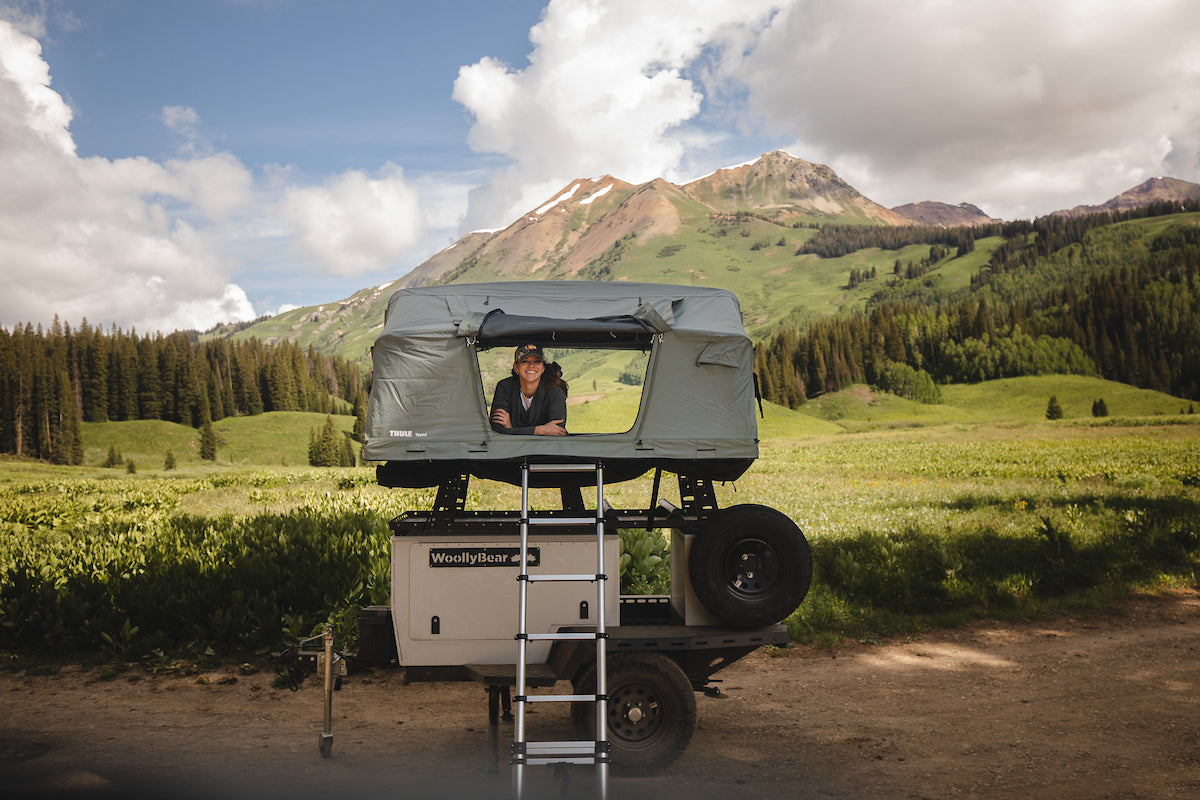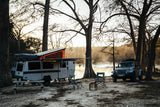Overland camping is an off-road adventure that puts all of your skills to the test. It's all about self-sufficiency between you and your vehicle as you attempt to rough it out in the wilderness, relying only on the amenities provided by your vehicle and gear.
We consider overlanding the ultimate outdoor experience as it helps connect you more with nature and yourself.
However, overlanding can be dangerous without the right equipment or know-how. That’s why TAXA’s X-Series are designed to handle the trail using an advanced suspension and to survive on the trail, providing you with enough creature comforts so that you don’t have to rub two sticks together.
Picking your trailer is just one of the many things you need for a successful overlanding adventure. Let’s explore!
Item #1. An Overland Vehicle
They say the hardest part of the journey is getting there, and that’s literally true if you don’t have a vehicle equipped to handle off-roading.
While we recommend an overlanding trailer for the ultimate camping setup with a pop-up roof and outdoor kitchen, any type of overlanding vehicle will work, depending on how much you want to rough it.
While we’ll discuss some of the features you’ll need for overlanding, suffice it to say that your vehicle will need a suspension built to handle off-roading.
For example, TAXA’s Overland models feature upgraded urethane bushings, progressive rubber springs, and an axle-less suspension that make them better equipped to handle obstacles without leaving you stuck.
Item #2. Off-Road Tires
Oversized tires increase ground clearance, but you still need to pick the right type to provide grip in the terrain you're exploring. For the most part, a set of good all-terrains will do just fine.
They provide a good grip on dirt and rocks and remain comfortable on the highway. If you are taking a camper trailer, it should also have tires that match the intended use, which are standard on TAXA Overlanding edition campers.
Item #3. Recovery Gear
Recovery gear is essential for getting you and your vehicle stuck out of a jam. Having a winch on the overlanding vehicle is a must, as it will allow you to pull your vehicle or other vehicles out of dangerous obstacles, such as mud or treacherous terrain. Other essential recovery gear include:
- Recovery straps
- Recovery boards
- Gloves
- A winch rope blanket
A tree saver is also essential to protect the trees you anchor your winch to, which will help preserve the environment while you explore it.
Item #4. Navigation
Getting lost on the trail is a real risk when overlanding, especially as it’s easy to lose cell service. Maps and atlases are essential when technology isn't an option.
You should always keep one in your glove box, just in case. However, GPS systems and apps specifically for navigating trails are available and will make it easy to stay the course when you're offline.
Item #5. Proper Lighting
Visibility is crucial, especially as there are no streetlights where you will be going. Make sure you have strong LED or halogen lights that can provide enough light to see down dark and narrow paths.
Adding light bars and cube lights can also increase visibility on the trail, as well as the visibility of your vehicle to other vehicles on the trail.
We also recommend including rock lights to see obstacles near the sides of your truck and lights at the rear to see anything behind it when you reverse.
As a final note, include lights to illuminate your campsite at night so you can find your way back!
Item #6. Camper/Sleeping Arrangement
Your sleeping arrangement is a definitive part of the adventure. Overlanders famously convert truck beds and the rear cargo area of SUVs into sleeping spaces.
Rooftop tents are another great option to consider. Of course, TAXA’s Overland Trailers feature habitats designed to sleep multiple people comfortably while putting you closer to nature.

Item #7. Food Storage and Cooking Equipment
Food and food storage are critical aspects of an overland camping trip unless you plan to hunt or fish to feed yourself. It’s one reason we recommend overlanding trailers, as they provide you with ample storage space for food and beverages while also providing the equipment to cook them.
If you don’t have a full kitchen galley on hand, as the TAXA Mantis provides, then you’ll have to settle for a portable grill and cooler.
Item #8. Water Storage
Water is another essential supply that often gets overlooked when packing for a long camping trip. Luckily, most campers have built-in water tanks and plumbing to work around the issue.
If you're going without, plan to bring 1-1.5 gallons of water per person per day. You should also bring along means of water purification in case you need to gather water from nature in an emergency.
Item #9. First Aid Supplies
While nobody likes to think about what can go wrong, you should be prepared for when they do. A first aid kit is a great start to deal with general injuries.
You can also add a few additional supplies to best match your specific situation. Snake bite kits, allergy medication, and emergency blankets are all great additions to consider. Also, be sure to bring a surplus of any medication for existing conditions as well.
Item #10. Basic Tools (General/Vehicle)
People aren't the only ones that can be injured while overlanding. Off-roading is hard on vehicles and trailers.
That's why you should always bring some tools and supplies to perform basic repairs on the trails. Since tires are the most likely point of failure, repair kits, inflators, and a spare tire should all be part of the kit.
Item #11. A Plan
A well-thought-out plan is critical to any overlanding experience. Without one, you're asking for trouble.
Take the time to map out your trip, make note of all the places you want to stop, and any camping spots to avoid getting lost. Then, tell someone that plan before you leave and when you expect to be back. That way, if anything goes wrong, they will know when and where to start looking for you.
Thanks to improved suspension systems, top-of-the-line travel trailers, and new travel gear, it’s never been easier to go overlanding with a recreational vehicle.
However, even all the gear in the world can't save you from poor preparation. Follow the tips above to have a safe and successful overlanding adventure, whether you’re riding in a TAXA trailer, a Jeep, or any kind of vehicle built for the trail.
FAQs
What type of vehicle is best for overland camping?
Pickup trucks and SUVs generally make the best overlanding vehicles. They're off-road capable and can easily support all of your gear.
However, nothing can beat the luxury of camping with a pop-up Overlanding trailer. Between access to full kitchen storage, battery units to charge your devices, and a rooftop tent to sleep comfortably under the stars, an overlanding trailer is the best vehicle designed for off-road camping.
What is an Overland camper?
An Overland camper is a model intended for off-road use. Off-road suspension, tires, and a hitch coupler built for the abuse are defining components of TAXA Outdoor's X-Series and Overlanding campers.
Lightweight and compact models are also best for Overlanding as they're easier to tow through tight trailers.
How do I choose between a tent and a roof-top tent for overland camping?
Budget and packaging are your two biggest concerns. Rooftop tents are great if you can afford them and if you have plenty of overhead room to work with on the trails you're visiting.
If trails are tight and you have a small budget to work with, a regular tent is the better option. That said, rooftop tents aren’t just for trucks. They are an option for the TAXA TigerMoth Overlanding Edition camper for expanding living space.

